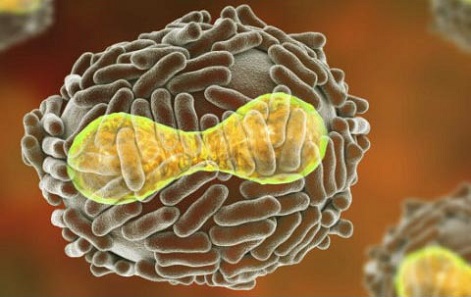Israeli researchers identify Viroporins in Mpox virus that can be exploited for treatments
Nikhil Prasad Fact checked by:Thailand Medical News Team Aug 26, 2024 7 months, 1 week, 1 day, 6 hours, 46 minutes ago
Medical News: Unveiling the Hidden Channels of the Mpox Virus
Researchers from The Hebrew University of Jerusalem-Israel have taken a significant step forward in understanding the Mpox (Monkeypox) virus, a member of the Poxviridae family, which has recently emerged as a global threat. With only two FDA-approved antiviral drugs currently available to combat this virus although both are proving not really effective in terms of dealing with the newer strains, the scientific community is racing against time to uncover new drug targets. This
Medical News report delves into a study that highlights the potential of targeting viroporins, viral ion channels, as a novel approach to inhibit the Mpox virus and curb its spread.
 Israeli researchers identify Viroporins in Mpox virus that can be exploited for treatments
Understanding the Mpox Virus and Its Threat
Israeli researchers identify Viroporins in Mpox virus that can be exploited for treatments
Understanding the Mpox Virus and Its Threat
The Mpox virus (MPXV) first made headlines in 1958 when it was discovered in primates. It wasn’t until 1970 that the virus was found to infect humans, primarily in Central and West African countries. However, since May 2022, the virus has spread to European countries, raising concerns about its global impact. The symptoms of Mpox, including muscle aches, fever, rash, and swollen lymph nodes, are similar to those of smallpox, though generally milder. Despite extensive research, only Tecovirimat and Brincidofovir have been approved by the FDA to treat Mpox, both of which target viral replication mechanisms.
The Search for New Drug Targets: Viroporins
Given the urgent need for additional treatment options, researchers have turned their attention to viroporins - small proteins that form ion channels within the host cell’s membrane. These channels are crucial for viral infectivity and represent an attractive target for antiviral drugs. The study, conducted by Kingshuk Basu, Miriam Krugliak, and Isaiah T. Arkin from The Hebrew University of Jerusalem, aimed to identify potential viroporins in the Mpox virus and explore their structural characteristics.
The Study: Identifying Potential Viroporins in Mpox
The research team employed a combination of bioinformatics and experimental assays to identify and characterize viral ion channels in the Mpox virus. They began by analyzing the virus’s genome, which is approximately 200 kb in size and encodes around 200 proteins. Using bioinformatics tools like Phobius and TMMHM, they identified eight small transmembrane proteins that were potential candidates for viroporins. These proteins, all less than 100 amino acids in length, included C20.5L, A15.5L, gp124, gp063, gp066, gp125, gp081, and gp120.
Experimental Assays: Testing the Ion Channel Activity
To confirm the ion channel activity of these proteins, the researchers conducted three independent bacterial-based assays. These assays are commonly used to evaluate the functionality of viroporins by measuring their impact on bacterial growth and ion flux.
-Negative Assay:
&
lt;br />
This assay measures the growth retardation of bacteria expressing the viral proteins, which indicates membrane permeabilization and ion channel activity. The results showed that most of the proteins caused significant growth inhibition, with gp124 exhibiting the highest activity.
-Positive Assay: In this assay, a K+-uptake deficient bacterial strain was used. The expression of viral ion channels that facilitate K+ transport results in enhanced bacterial growth. The researchers observed significant growth enhancement for gp120, A15.5L, gp081, C20.5L, and gp063, confirming their ion channel activity.
-pH Assay: The final assay involved measuring the proton influx kinetics in bacteria expressing the viral proteins. A pronounced pH drop, indicative of H+ transport, was observed for several proteins, including gp124, A15.5L, gp063, gp125, gp081, and gp066.
Computational Analysis: Predicting Protein Structures
Following the experimental validation, the research team utilized AlphaFold2, a state-of-the-art AI tool, to predict the structures of the top-performing ion channels. The structural models provided insights into the potential oligomeric forms of these proteins and their arrangement within a lipid bilayer.
Key Findings: A Step Toward Novel Antiviral Drugs
The study’s findings suggest that five of the eight identified proteins - A15.5L, gp081, gp120, gp063, and C20.5L - exhibit significant ion channel activity, making them promising candidates for further investigation as potential drug targets. The computational models revealed stable trimeric or tetrameric structures for these proteins, which could guide the development of small molecules or peptides that block these channels and inhibit the Mpox virus’s ability to replicate.
Conclusion: Paving the Way for Future Research
This study marks an important step in the fight against Mpox. By identifying and characterizing viroporins in the Mpox virus, researchers have opened new avenues for antiviral drug development. Targeting these ion channels could lead to the creation of more effective treatments, helping to control the spread of Mpox and potentially other related viruses.
The study findings were published in the peer-reviewed International Journal of Molecular Sciences.
https://www.mdpi.com/1422-0067/24/18/13828
For the Mpox News, keep on logging to Thailand
Medical News.
Read Also:
https://www.thailandmedical.news/news/mpox-evades-the-human-immune-system-by-having-its-viral-protein-m2-bind-to-host-b7-1-and-b7-2-proteins
https://www.thailandmedical.news/news/who-faces-criticism-over-two-year-delay-in-mpox-vaccine-access-for-africa-calls-for-tedros-resignation-grow
